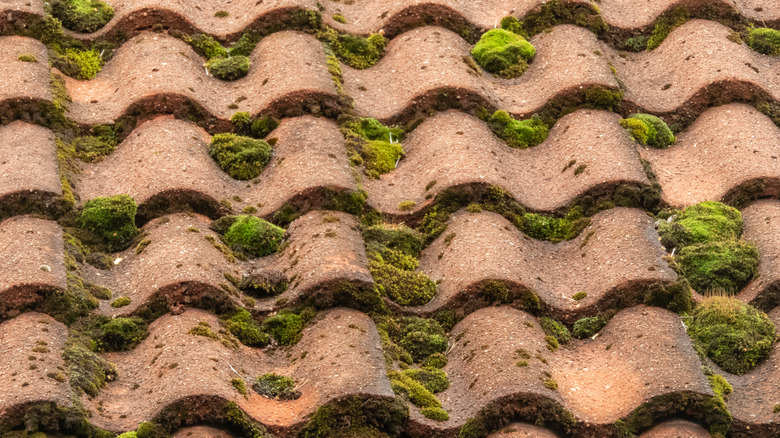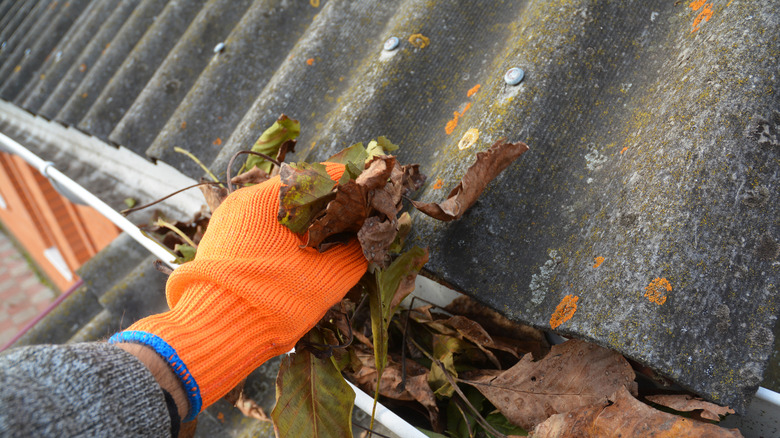The Most Effective Way To Eliminate Moss On Your Roof
If your chore list conveniently skips over cleaning off moss growth on your roof, you aren't alone. This job can be daunting, but ensuring your roof stays in good condition is essential. Moss can be detrimental to the shingles that protect your home from the elements, breaking down the materials over time. Scrubbing, washing, and applying chemicals will keep this growth from ruining your roof, giving it a longer life span.
You should make it a habit to clean moss every two or three years to keep the shingles in good condition. According to NW Moss Removal, applying the right chemicals will keep moss from spreading too quickly. In addition to applying chemicals, you should clean your gutters of water, leaves, and other refuse from wind and weather twice a year to prevent growth. Taking the proper steps to remove moss will make the job quick and easy and take the worry of roofing damage off of your shoulders.
Start with scrubbing the moss
Moss is known for its ability to hold on to and grow on various surfaces. Because of its grip, it can be hard to wipe off a surface. To remove moss from your roof, start by scrubbing it with a soft-bristled, long-handled brush. Always invest in protective gear before starting a project involving your roof. Roof Master & Construction recommends wearing a helmet and shoes with a rubber sole that offers a good amount of grip. Use the soft-bristled brush to gently remove moss, starting from the bottom of the shingles or surface and working your way up.
Be careful while scrubbing, always applying gentle pressure to avoid knocking off a shingle or the material layers that protect them. Asphalt shingles are tricky to scrub because the granules can come off with too much pressure. This is detrimental to the shingle, as these granules protect the layers underneath from the elements. As you scrub, focus on one section at a time, sticking to smaller areas. This ensures the brush is controlled and doesn't harm the shingles.
Wash the moss off
Once you've scrubbed the shingles, rinsing them off will help remove the remaining moss and dirt. According to Iko, you can use a garden hose, but ensure the pressure is on the lowest setting. High-powered pressure washers can damage your roof and cause a leak. Start at the top of your roof and work your way down with the water. This will wash everything off the surface and direct the water flow away from your home. Flat roofs still have a slight slant, so start in the middle and work your way out.
Pressure washers are abrasive and can break singles or damage the roofing materials, so avoid these if possible. The goal is to increase the longevity of your roof. While scrubbing and low-pressure water might take a little longer, these jobs are still relatively simple to complete and will preserve the integrity of your materials, preventing leaks or other damage.
Apply moss removing chemicals
After scrubbing and washing the moss off your roof, apply a moss remover to the surface. You can find moss killers in local stores, or create a mixture of water and chlorine bleach, according to Roof Master & Construction. Apply the solution to your roof, then let it soak in for 20 minutes. Make sure to mist in a downwards motion, using a spray bottle to cover the growth. The substance will target the spores that create moss and keep your roof from attracting it so quickly.
Always clear out your gutters because refuse and debris can build up, creating the perfect environment for moss to grow. Clear them out at least twice a year, removing dirt, leaves, and any other clutter left from strong winds or inclement weather. Rinse the gutters once everything has been removed so that no remaining spores can attract further moss growth. If you have trees that grow close to your house, cut back branches that overhang to ensure they don't drop leaves onto the roof or gutters. This will help reduce the amount of debris that falls onto your roof.



